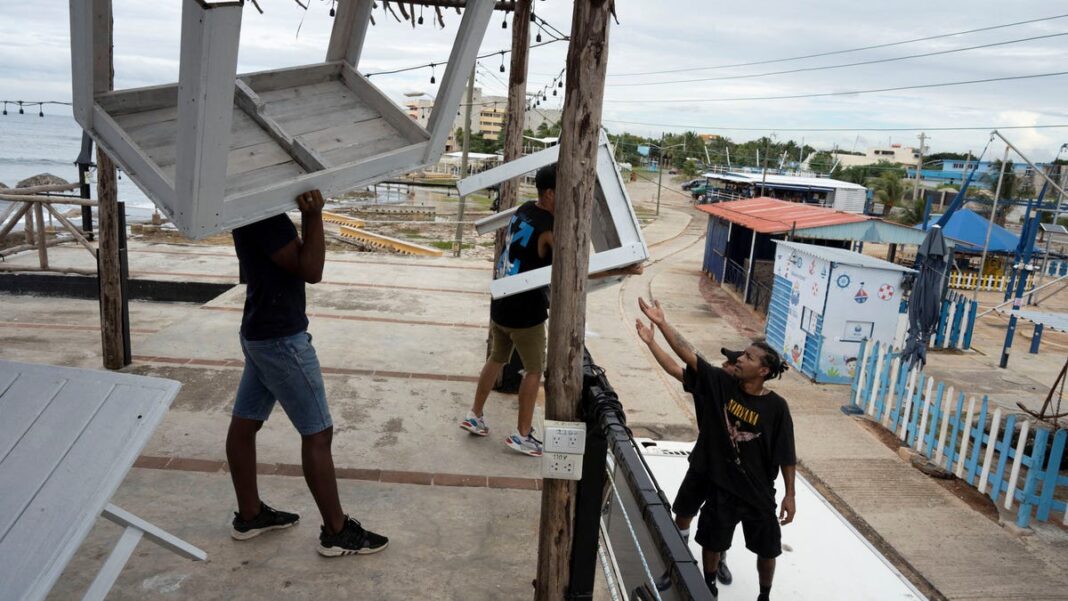Hurricane Rafael Reaches Category 3 Status as It Approaches Cuba: Anticipated Effects on the U.S.
Hurricane Rafael has intensified to a Category 3 storm as it moves closer to western Cuba, posing a significant threat before it heads into the Gulf of Mexico and towards the United States.
The National Hurricane Center reported that Rafael’s maximum sustained winds have increased to 115 mph. The storm is currently located 40 miles northeast of the Isle of Youth and 80 miles south of Havana. There are warnings of potentially “life-threatening storm surges” ranging from 6-10 feet in certain areas, along with the risk of flash flooding.
Cuba is still recovering from Hurricane Oscar, a Category 1 storm that brought heavy rainfall and resulted in at least six fatalities last month, leading to the collapse of its electrical infrastructure. The already saturated soil heightens the risk of flash floods and mudslides as Rafael approaches.
In light of the danger, over 60,000 people have evacuated the eastern province of Guantánamo due to ongoing thunderstorms causing destructive floods. Ahead of Rafael, government offices and schools have closed, and several public transport services have been suspended.
Is the U.S. in Hurricane Rafael’s Path?
As Rafael crosses western Cuba on Wednesday afternoon, it is expected to continue into the Gulf of Mexico that evening, still as a hurricane, although it may weaken somewhat after passing over the island. The National Hurricane Center indicates that tropical storm conditions may reach the Florida Keys, with potential for tornado activity on the southwestern mainland of Florida.
The hurricane is anticipated to weaken in the Gulf because of wind shear, drier conditions, and cooler waters. The NHC advises that it’s premature to determine the potential effects on the Gulf Coast of the U.S.
Forecast models vary significantly, suggesting the storm could impact areas from eastern Mexico to Texas, Louisiana, Mississippi, and the Florida Panhandle.
Bill Deger, a meteorologist at AccuWeather, noted that even minor changes in Rafael’s strength and wind patterns could drastically alter its path. He added that there exists a possibility Rafael could be dismantled by intense upper atmospheric winds, potentially fading in the Gulf before reaching land.
AccuWeather highlights that the highest likelihood of landfall is along the central Louisiana coastline, but factors from a concurrent storm in the south-central U.S. add uncertainty to the prediction. The NHC also mentioned that there is “greater-than-normal uncertainty regarding Rafael’s intensity during later forecasts.”
Even if it weakens, Rafael will maintain sufficient strength to produce hazardous waves and dangerous surf conditions along the coast, according to the hurricane center.
A New Storm Emerges Behind Rafael
As Rafael approaches Cuba, meteorologists are also keeping an eye on a developing storm in the Caribbean Sea.
A low-pressure system generating showers and thunderstorms is positioned several hundred miles northeast of the Leeward Islands, as reported by the National Hurricane Center on Wednesday.
Forecasters project that this system could evolve into the next named storm of the 2024 Atlantic hurricane season as it moves westward towards the Virgin Islands and Puerto Rico, subsequently approaching the Bahamas.
Rafael marks the 17th named storm of the 2024 Atlantic hurricane season, according to Phil Klotzbach, a hurricane researcher at Colorado State University. The average year typically has 14 named storms.
This latest hurricane is the 11th of the season, significantly higher than the average of seven. Meteorologists attribute the unprecedented activity this year partly to unusually high ocean temperatures. Klotzbach noted that only seven other seasons have recorded 11 hurricanes in the Atlantic by this date since comprehensive records began in 1851.
(This story was updated to include recent information.)

